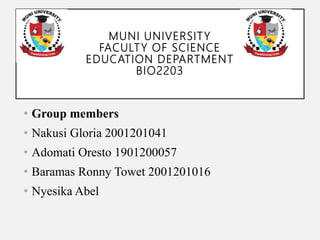
bio2203.pptx
- 1. MUNI UNIVERSITY FACULTY OF SCIENCE EDUCATION DEPARTMENT BIO2203 • Group members • Nakusi Gloria 2001201041 • Adomati Oresto 1901200057 • Baramas Ronny Towet 2001201016 • Nyesika Abel
- 2. OBTAINING SAMPLE FOR HISTOLOGY Tissues Collection • The tissue is removed from the animal body or plant part. • Tissue submitted for histopathology must not be more than 1cm3 thick (ideal size). • Most specimens from solid tissues are cut in the form of pieces measuring 10 to 15 mm on the slides and 2 to 3 mm in thickness. • Small fragments of tissue must be wrapped in thin paper. • Placed in a fixative which stabilizes the tissues to prevent decay The most common fixative is formalin (10% formaldehyde in water)
- 3. Illustration
- 4. • This will slowly penetrate the tissue causing chemical and physical changes that will harden and preserve the tissue and protect it against subsequent processing.
- 5. • Fixation should be carried out as soon as possible after removal of the tissues or soon after death to prevent autolysis. There is no perfect fixative. • The fixatives depend on the type of tissue present.
- 6. Importance Of fixation • To prevent autolysis and bacterial attack. To fix the tissues so they will not change their volume and shape during processing • To prepare tissue and leave it in a condition which allow clear staining of sections • To leave tissue as close as their living state as possible, and no small molecules should be lost.
- 7. • Processing of Tissue Embed the tissue in a solid medium firm enough to support the tissue and give it sufficient rigidity to enable thin sections to be cut and yet soft enough not to damage the knife or tissue. Stages of processing Dehydration, Clearing, Infiltration & Impregnation, Embedding, Sectioning, Staining, Mounting
- 8. Dehydration • Water is completely removed from fixed tissue Procedure • Tissue blocks are place in capsules (Cassettes) • These tissues are passed through a series of increasing concentration of alcohol • 2 bath in 80 % alcohol for 1hour • 1 bath in 90 % alcohol for 1hour • 3 bath in 100 % alcohol for 1hour
- 9. Clearing An intermediate solvent that is fully miscible with both ethanol and paraffin wax is used. This solvent will displace the ethanol in the tissue, then this, in turn, will be displaced by molten paraffin wax. This stage in the process is called “clearing” and the reagent used is called a “clearing agent”. Reagents are; Xylene, Chloroform, Benzene, Carbon tetrachloride Procedure • 2 bath in Clearing agent for 1hour
- 10. Infiltration And Impregnation • Clearing agent is eliminated from the tissue by diffusion into the surrounding melted wax (infiltration) • A typical wax is liquid at 60°C and can be infiltrated into tissue at this temperature then allowed to cool to 20°C, where it solidifies to a consistency that allows sections to be consistently cut.
- 11. Embedding Or Blocking Out • The infiltrated and impregnated tissue is placed in warm quid paraffin, which forms a firm block after cooling. Procedure • Paraffin wax is first melt 56°C to 58°C and filter through course filter paper. Fill mold with paraffin. Place tissue in mold • The mold is then placed in a container of cold water or kept in refrigerator for 10 to 20 minutes.
- 13. • Sectioning • Cut biological specimens into very thin sections for microscopic • Procedure • Trim the block with a knife until 1 to 3mm of paraffin remains all side of the tissue. • Fix the block in the block holder of the microtome. Insert tightly a knife in the knife holder with proper position. • Cut sufficient sections.
- 14. Frozen Section • The frozen section is a technique in which tissue is frozen rapidly to the temperature of -20°C and the sections are cut and stained. • Tissue can be examined microscopically within 5-10 minutes of its removal from the body • It reduces the time of processing from 18 hours to 5 minutes.
- 15. Staining Staining is used to highlight important features of the tissue as well as to enhance the tissue contrast. The most common stain applied for histological study is Haematoxylin and Eosin. Washing and rinsing of tissue sections is a necessary part of most staining techniques. It eliminates carrying over of one dye solution to the next.
- 16. Cover slipping and mounting Hold the slide between the thumb and the forefinger of one hand and wipe with a clean cloth both ends of the slides. Look for the engraved number to make sure the side the sections is present. Clean carefully around the section and lay on a clean blotting paper with section uppermost along with appropriate coverslip which has already been polished. Place a drop of mountant on the slide over coverslip. Amount of mountant should be just enough. Invert the slide over the coverslip and lower it so that it just adheres to the cover slip quickly turn the slide over, then lay it on a flat surface to allow the mountant to spread. Do not press or push the slide at all. It can damage the section.